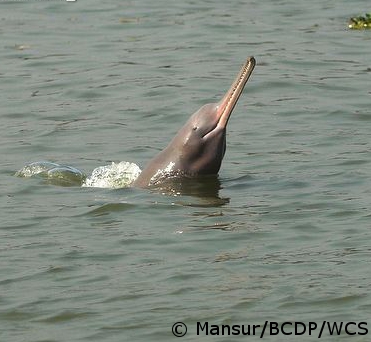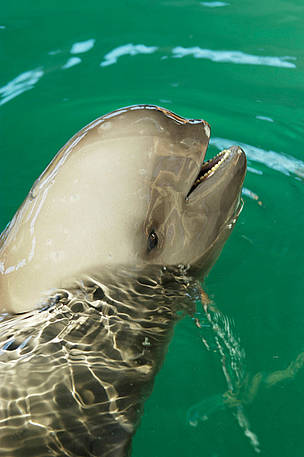I have been turning over this idea in my head for some time. Thanks to some encouragement I have decided to pull the trigger. Every week or so I will be informally and broadly discussing one of natures incredible creatures. I will be taking my subjects from all three domains of life and will hopefully provide fun, interesting, and sometimes sobering facts about the living world around us.
Today my spotlight falls on Baiji, the Yangtze River Dolphin.

(baby Baiji, unsourced, no time stamp) edit: being ever wanting to improve myself I did some digging on this picture, it is not a Baiji, rather it was a bottlenose dolphin rescue. I will keep it up because it is cute.
Among the rarest and most threatened living things on the planet, Baiji was declared functionally extinct in 2007 after an extensive collaborative surveying effort. Occasional sightings since then have kept the sliver of hope for saving Baiji from extinction alive and they are still officially classified as critically endangered on the IUCN Red List of Endangered Species. The population has been steadily falling since at least the 1950's and was estimated to be only 13 strong in the 1990's. Breeding programs have been completely unsuccessful as no Baiji have ever been born in captivity and as of right now not a single specimen remains in captivity. Beat Mueller, geochemist at the Swiss Federal Institute of Aquatic Science and Technology and member of the 2006 survey team had this to say about the threats to the Baiji.

(Historic range of the Baiji, from edgeofexistence.org)
The Baiji were endemic to the lower and middle Yangtze river system and occupied a vital niche along the 1600 kilometers as a keystone predator. Conservation efforts along the Yangtze river began in the 1970's. Five nature preserves were established and attempts to keep and breed the Baiji in captivity began in earnest. Most of the captive Baiji died in less than a year. Certain fishing practices were also made illegal to almost no effect in the mid 90's. Yet illegal fishing practices, including rolling hook liens and electro-fishing continued to be perhaps the most destructive force to the Baiji's population. Some estimates put 50% of the death rate over the past 40 years on the use of rolling hook lines alone. More extreme conservation efforts were to include a relocation to a well protected and semi natural site on a bend in the Yangtze river proposed by Wang Ding head of the Baiji team at China's Institute of Hydrobiology similar to the somewhat successful program for the finless porpoise, also endemic to the Yangtze river. This program will relocate entire pods of Baiji, if they are ever found again. Wang had this to say to National Geographic in August of 2007 about the extreme preservation efforts proposed by his team.
I hope he finds a way to complete his mission.
Although visually similar to other river dolphins genetic studies showed them to be the only species of a unique family of cetaceans that began exploring the Yangtze some 20 million years ago. Like all dolphins they relied heavily on echolocation to find prey. Like most river dolphins their eyes were greatly reduced being all but useless in the murky river habitat in which they once thrived.

(Photo by Wang Ding, Institute of Hydrobiology, Chinese Academy of Sciences.)
At around 8 feet long and five hundred pounds they were on the larger size compared to the other three families of still extant river dolphins. They are blue to grey along their backs and very pale along their bellies, which gave rise to one of their other common names the white finned dolphin. Being a very difficult species to study, little was known about their behavior. Calves, measuring only 80–90 centimeters (31–35 in) at birth, were born after 10 to 11 months of gestation. They reached sexual maturity at 4 years. Only two Baiji survived longer than one year in captivity, the most successful died after 22 years, giving us the only estimate for lifespan at around 25 years.

(Photograph © Chinese Academy of Sciences/WWF depicts the Baiji mentioned above)
The National History Museums Farewell to the Baiji
For more reading
http://news.nationalgeographic.com/news/2007/08/070831-baiji-dolphin.html
http://www.nmfs.noaa.gov/pr/species/mammals/cetaceans/chineseriverdolphin.htm
http://www.iucnredlist.org/details/12119/0
http://en.wikipedia.org/wiki/Baiji
If you have questions please ask, if you want to provide more detail please do. I am also willing to take suggestions for a Creature Spotlight #2. I promise the next one won't be so depressing.
Thanks to maxcriden and Qasiel for believing this is a worthwhile contribution to a video game forums off topic section. Qasiel You got your dolphin, though I imagine it is bittersweet.
Today my spotlight falls on Baiji, the Yangtze River Dolphin.

(baby Baiji, unsourced, no time stamp) edit: being ever wanting to improve myself I did some digging on this picture, it is not a Baiji, rather it was a bottlenose dolphin rescue. I will keep it up because it is cute.
Among the rarest and most threatened living things on the planet, Baiji was declared functionally extinct in 2007 after an extensive collaborative surveying effort. Occasional sightings since then have kept the sliver of hope for saving Baiji from extinction alive and they are still officially classified as critically endangered on the IUCN Red List of Endangered Species. The population has been steadily falling since at least the 1950's and was estimated to be only 13 strong in the 1990's. Breeding programs have been completely unsuccessful as no Baiji have ever been born in captivity and as of right now not a single specimen remains in captivity. Beat Mueller, geochemist at the Swiss Federal Institute of Aquatic Science and Technology and member of the 2006 survey team had this to say about the threats to the Baiji.
The disappearance and extinction of such highly evolved endemic mammals as the white Yangtze River dolphin [baiji], the finless porpoise, or the Chinese sturgeon from the Yangtze River can be attributed to a multitude of circumstances, such as the deterioration and loss of their natural habitats, over fishing of the river, the heavy freight ship traffic, and others

(Historic range of the Baiji, from edgeofexistence.org)
The Baiji were endemic to the lower and middle Yangtze river system and occupied a vital niche along the 1600 kilometers as a keystone predator. Conservation efforts along the Yangtze river began in the 1970's. Five nature preserves were established and attempts to keep and breed the Baiji in captivity began in earnest. Most of the captive Baiji died in less than a year. Certain fishing practices were also made illegal to almost no effect in the mid 90's. Yet illegal fishing practices, including rolling hook liens and electro-fishing continued to be perhaps the most destructive force to the Baiji's population. Some estimates put 50% of the death rate over the past 40 years on the use of rolling hook lines alone. More extreme conservation efforts were to include a relocation to a well protected and semi natural site on a bend in the Yangtze river proposed by Wang Ding head of the Baiji team at China's Institute of Hydrobiology similar to the somewhat successful program for the finless porpoise, also endemic to the Yangtze river. This program will relocate entire pods of Baiji, if they are ever found again. Wang had this to say to National Geographic in August of 2007 about the extreme preservation efforts proposed by his team.
The chances of saving the baiji are really small, But we have to try our best to save the last baiji, even if we know it may be a mission impossible."
I hope he finds a way to complete his mission.
Although visually similar to other river dolphins genetic studies showed them to be the only species of a unique family of cetaceans that began exploring the Yangtze some 20 million years ago. Like all dolphins they relied heavily on echolocation to find prey. Like most river dolphins their eyes were greatly reduced being all but useless in the murky river habitat in which they once thrived.

(Photo by Wang Ding, Institute of Hydrobiology, Chinese Academy of Sciences.)
At around 8 feet long and five hundred pounds they were on the larger size compared to the other three families of still extant river dolphins. They are blue to grey along their backs and very pale along their bellies, which gave rise to one of their other common names the white finned dolphin. Being a very difficult species to study, little was known about their behavior. Calves, measuring only 80–90 centimeters (31–35 in) at birth, were born after 10 to 11 months of gestation. They reached sexual maturity at 4 years. Only two Baiji survived longer than one year in captivity, the most successful died after 22 years, giving us the only estimate for lifespan at around 25 years.

(Photograph © Chinese Academy of Sciences/WWF depicts the Baiji mentioned above)
The National History Museums Farewell to the Baiji
For more reading
http://news.nationalgeographic.com/news/2007/08/070831-baiji-dolphin.html
http://www.nmfs.noaa.gov/pr/species/mammals/cetaceans/chineseriverdolphin.htm
http://www.iucnredlist.org/details/12119/0
http://en.wikipedia.org/wiki/Baiji
If you have questions please ask, if you want to provide more detail please do. I am also willing to take suggestions for a Creature Spotlight #2. I promise the next one won't be so depressing.
Thanks to maxcriden and Qasiel for believing this is a worthwhile contribution to a video game forums off topic section. Qasiel You got your dolphin, though I imagine it is bittersweet.





